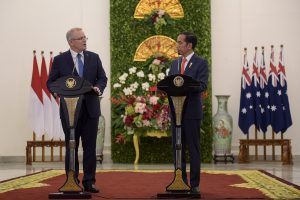Earlier this week, Indonesian President Joko “Jokowi” Widodo completed his latest visit to Australia. While the trip itself was just among a series of interactions between the two countries to manage their complex relationship and the official agenda was wide-ranging, the visit also spotlighted the growing Indo-Pacific dimension in their bilateral relationship.
As I have observed before in these pages, beyond the U.S. Free and Open Indo-Pacific Strategy, which has tended to dominate the headlines, Indonesia and Australia have been among the countries that have been active in promoting their own visions of the Indo-Pacific, which they had set out previously, with manifestations of this including Jakarta’s Global Maritime Fulcrum (GMF) or Australia’s Pacific Step-up.
As this has occurred, we have also seen both countries attempt to highlight convergences between their visions for the Indo-Pacific as well. Indications of this have been seen with respect to aspects of their bilateral relationship, such as maritime security, as well as in their ties with other countries, with a case in point being the emerging trilateral cooperation between them and India.
While Jokowi’s recent visit saw both sides discuss a range of issues, it also spotlighted the Indo-Pacific convergences between the two countries as well. We saw some of these aspects highlighted in engagements during Jokowi’s visit, with a case in point being Jokowi’s address to the Australian parliament where, beyond areas of strict bilateral cooperation, he also noted that that Australia and Indonesia could both serve as “anchors” for “developing partners in the Pacific region” given the extent of development challenges in the region.
The joint statement between the two countries during Jokowi’s visit also highlighted some of the areas of convergence within the Indo-Pacific. Quantitatively, 10 of the 45 points in the joint statement were devoted to a separate section on the Indo-Pacific, which was the largest number of any section tied with the section on bilateral and regional security. Qualitatively, this included noting areas of convergence – such as trilateral development in the South Pacific and support for ending IUU fishing and preventing terrorist exploitation on the Internet at the G-20 – as well as more substantive steps such as the elevation of the Indonesia-Australia-India Strategic Dialogue to the foreign ministers’ level and the formation of a new Indonesia-Australia Partnership in Disaster Risk Management and a Indonesia-Australia Health Security Partnership.
To be sure, the visit naturally focused on the opportunities inherent in convergences between Indonesia and Australia with respect to the Indo-Pacific, rather than its challenges which are rooted in various factors including the limitations each faces in their approaches to the Indo-Pacific, differing interests by both sides, as well as issues that remain to be addressed in a bilateral relationship that has continued to see its share of ups and downs. And at this stage, some of the areas of Indo-Pacific cooperation mentioned remain more aspirations rather than realities.
Nonetheless, as we see continued focus on the Indo-Pacific as a strategic concept, how Jakarta and Canberra think, speak, and act in this space – both separately and together – will be a key factor in how developments evolve. Seen from that perspective, Jokowi’s visit served as an important reminder of that reality.

































